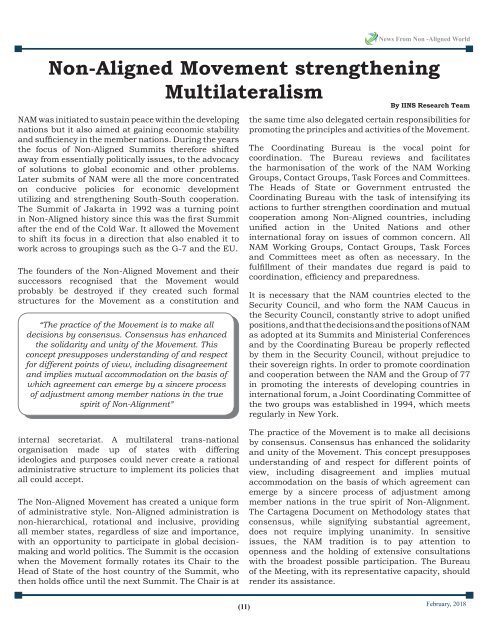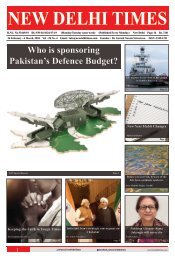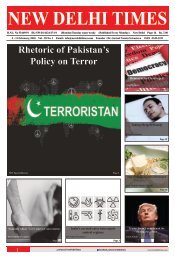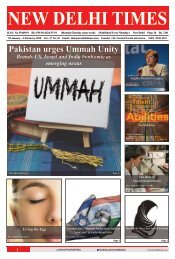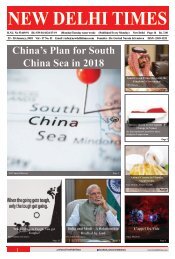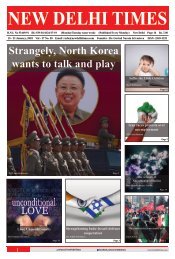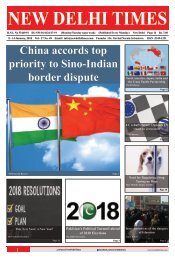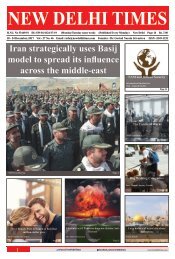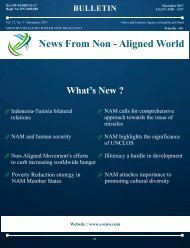10 february 2018_final
You also want an ePaper? Increase the reach of your titles
YUMPU automatically turns print PDFs into web optimized ePapers that Google loves.
Non-Aligned Movement strengthening<br />
Multilateralism<br />
By IINS Research Team<br />
NAM was initiated to sustain peace within the developing<br />
nations but it also aimed at gaining economic stability<br />
and sufficiency in the member nations. During the years<br />
the focus of Non-Aligned Summits therefore shifted<br />
away from essentially politically issues, to the advocacy<br />
of solutions to global economic and other problems.<br />
Later submits of NAM were all the more concentrated<br />
on conducive policies for economic development<br />
utilizing and strengthening South-South cooperation.<br />
The Summit of Jakarta in 1992 was a turning point<br />
in Non-Aligned history since this was the first Summit<br />
after the end of the Cold War. It allowed the Movement<br />
to shift its focus in a direction that also enabled it to<br />
work across to groupings such as the G-7 and the EU.<br />
The founders of the Non-Aligned Movement and their<br />
successors recognised that the Movement would<br />
probably be destroyed if they created such formal<br />
structures for the Movement as a constitution and<br />
“The practice of the Movement is to make all<br />
decisions by consensus. Consensus has enhanced<br />
the solidarity and unity of the Movement. This<br />
concept presupposes understanding of and respect<br />
for different points of view, including disagreement<br />
and implies mutual accommodation on the basis of<br />
which agreement can emerge by a sincere process<br />
of adjustment among member nations in the true<br />
spirit of Non-Alignment”<br />
News From Non -Aligned World<br />
the same time also delegated certain responsibilities for<br />
promoting the principles and activities of the Movement.<br />
The Coordinating Bureau is the vocal point for<br />
coordination. The Bureau reviews and facilitates<br />
the harmonisation of the work of the NAM Working<br />
Groups, Contact Groups, Task Forces and Committees.<br />
The Heads of State or Government entrusted the<br />
Coordinating Bureau with the task of intensifying its<br />
actions to further strengthen coordination and mutual<br />
cooperation among Non-Aligned countries, including<br />
unified action in the United Nations and other<br />
international foray on issues of common concern. All<br />
NAM Working Groups, Contact Groups, Task Forces<br />
and Committees meet as often as necessary. In the<br />
fulfillment of their mandates due regard is paid to<br />
coordination, efficiency and preparedness.<br />
It is necessary that the NAM countries elected to the<br />
Security Council, and who form the NAM Caucus in<br />
the Security Council, constantly strive to adopt unified<br />
positions, and that the decisions and the positions of NAM<br />
as adopted at its Summits and Ministerial Conferences<br />
and by the Coordinating Bureau be properly reflected<br />
by them in the Security Council, without prejudice to<br />
their sovereign rights. In order to promote coordination<br />
and cooperation between the NAM and the Group of 77<br />
in promoting the interests of developing countries in<br />
international forum, a Joint Coordinating Committee of<br />
the two groups was established in 1994, which meets<br />
regularly in New York.<br />
internal secretariat. A multilateral trans-national<br />
organisation made up of states with differing<br />
ideologies and purposes could never create a rational<br />
administrative structure to implement its policies that<br />
all could accept.<br />
The Non-Aligned Movement has created a unique form<br />
of administrative style. Non-Aligned administration is<br />
non-hierarchical, rotational and inclusive, providing<br />
all member states, regardless of size and importance,<br />
with an opportunity to participate in global decisionmaking<br />
and world politics. The Summit is the occasion<br />
when the Movement formally rotates its Chair to the<br />
Head of State of the host country of the Summit, who<br />
then holds office until the next Summit. The Chair is at<br />
The practice of the Movement is to make all decisions<br />
by consensus. Consensus has enhanced the solidarity<br />
and unity of the Movement. This concept presupposes<br />
understanding of and respect for different points of<br />
view, including disagreement and implies mutual<br />
accommodation on the basis of which agreement can<br />
emerge by a sincere process of adjustment among<br />
member nations in the true spirit of Non-Alignment.<br />
The Cartagena Document on Methodology states that<br />
consensus, while signifying substantial agreement,<br />
does not require implying unanimity. In sensitive<br />
issues, the NAM tradition is to pay attention to<br />
openness and the holding of extensive consultations<br />
with the broadest possible participation. The Bureau<br />
of the Meeting, with its representative capacity, should<br />
render its assistance.<br />
(11)<br />
February, <strong>2018</strong>


